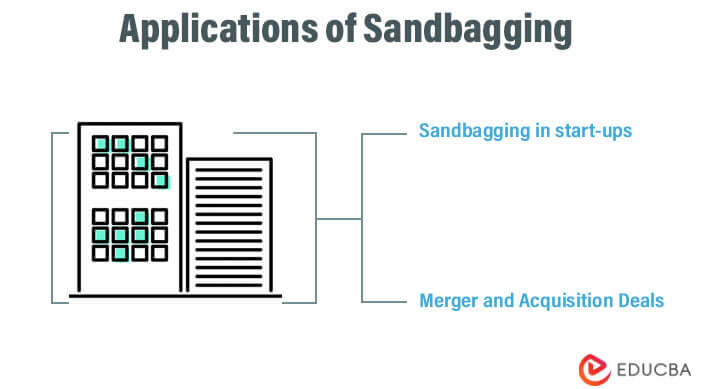Updated July 21, 2023
Introduction to Sandbagging
Sandbagging is reducing a company’s expectations by diminishing its strength and core competencies to generate a result that exceeds its expectation or what was anticipated. A company’s top management primarily does this to lower the expectation of its shareholders.
Explanation
In sandbagging, a company’s top management generally tends to issue lower guidance than the actual scenario to its shareholders. This means management purposely lowers the projected earnings and overall performance KPIs. During the consecutive period when the company shows a better picture or likes better than expected results, the investors and shareholders feel even more grateful and impressed with its performance considering the earlier scene where the company had sandbagged the profits. Thus it is more of a deceptive strategy where the company’s top management lowers the company’s expectations, hides its profit earned and portrays a gloomy picture to its shareholders.
How Does it Work?
Sandbagging is a strategy company’s use to prepare the expectation of their financial statement by shareholders and others involved with the business on a lower front where the company has performed well or outperformed its expectation. When the company has done good business or met its objectives to shareholders during a consecutive period, it looks like it has over-performed its expectations. Thus it brings about joy to shareholders. Companies will utilize this strategy by taking control of investor expectations using analyst reports, media-generated reports, and press releases.
Thus by lowering the expectation of its shareholders, the company will create a self-defined zone for itself where it depicts that it has lowered expectations but still outperformed in the next consecutive period, which helps to gain shareholder confidence and increment in the share price of the company adding in the overall financial strength of the business. This is a very important strategy to prevent a sudden deviation in investor expectation which might affect a company’s share price and, in return, affect the overall financial health of the business too. It is not only used by established businesses, but start-ups also apply this strategy.
Here the newly formed company will show an understated result than what they have performed to attract investors after the announcement of the actual result, which will show that the company has outperformed its expectation. It is also applied in the field of merger and acquisition by the pro sandbagging clause, which protects the purchaser’s or acquirer’s right and interest.
Example of Sandbagging
Let us discuss a scenario related to the stock price of a company. Before releasing their financial result for a period, companies use these techniques to control investor and shareholder emotions and expectations, thus bringing about share price fluctuation. Suppose a company has its financial report due to be released in a few weeks, and this is when it makes use of its in-house analysts to make a forecast for the company in their reports stating that the company expects stable growth based on its predicted earnings. In reality, the company has performed well and is supposed to have a double-digit profit and over-perform its expectations.
Thus in this way, the company captures the sentiment of the shareholders who, based on the analyst reports, think the company has performed on a stable basis. When the actual result is announced, the numbers in the financial statement show above-average growth and shareholders are impressed that the company has performed beyond what was expected. This leads to a strong buy signal for the shares of the company with immediate growth in the share prices. It is all about public sentiment, which drives the prices of the stock, and in this way, the company makes more money with greater market capitalization.
Applications of Sandbagging
Sandbagging finds its application in many fields of finance which is discussed below:
a) Sandbagging in Start-ups
A start-up will adhere to sandbagging to attract investors for future funding. Start-ups will use this method of sandbagging their profits by giving understated earning updates and estimates to show they will achieve below what was expected. However, when actual results are out, it gives the impression that the company has outperformed and exceeded shareholder expectations. Start-ups will use this technique not only to gain the trust of existing shareholders but also to attract new potential investors to their business. When investors find the company outperforming its expectation constantly, they show interest in funding that business perceiving it as a promising business opportunity.
b) It is in Merger and Acquisition Deals
Every merger and acquisition deal will contain a pro sandbagging clause. This clause protects the interest of the purchaser or the acquirer where the merged or acquired company is bound to correctly disclose all the information about the company to the acquirer. Sometimes, the seller may sandbag some information about the company and not disclose it all to the buyer or acquirer. This should have been disclosed, but in some cases, the seller deliberately sandbags or hide such information from the buyer or the acquirer. Thus under the pro sandbagging clause, the acquirer has the right to incur losses due to some information by the seller when the deal was made. Therefore even after closing the transaction, if such sandbagging of data had occurred and the acquirer has made up losses, the seller is bound to make up for such losses.
Conclusion
Sandbagging may be perceived as a very effective strategy, but the usage of this strategy over a prolonged period can have a drastic effect on the company. Thus, this strategy is limited and restricted overtime only. It is a very good strategy for start-ups because it can help them gain access to additional funds for investment and set up or expand the business.
Recommended Articles
This is a guide to Sandbagging. Here we discuss the introduction to Sandbagging, how it works with explanations, examples, and the application. You can also go through our other related articles to learn more –



